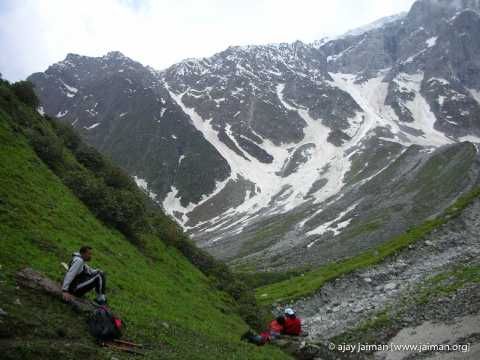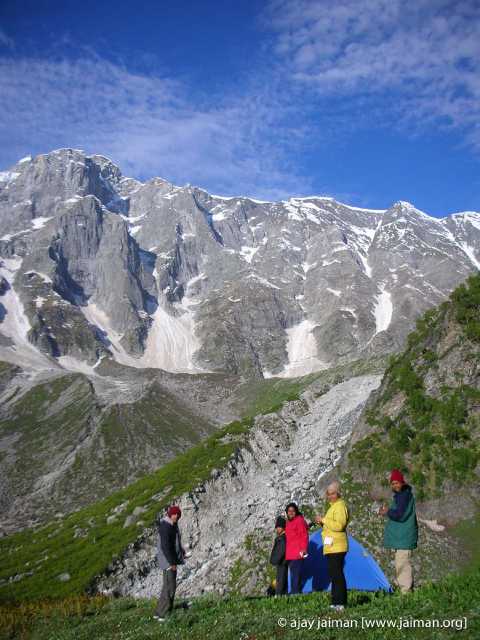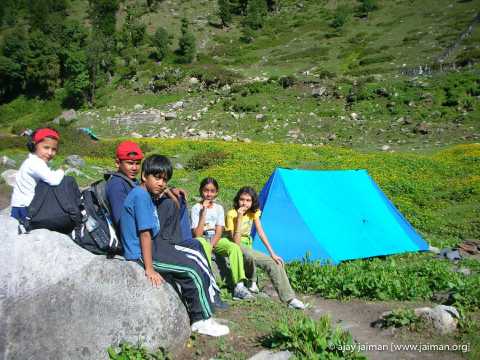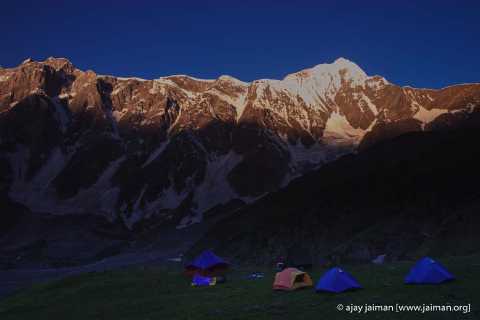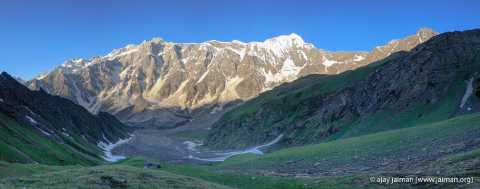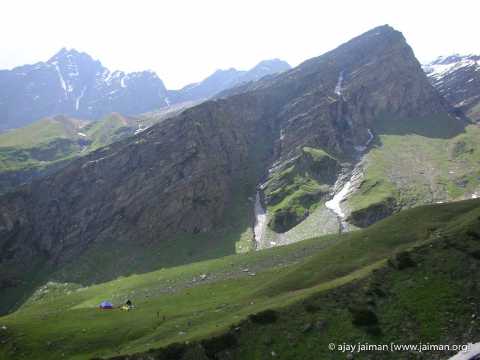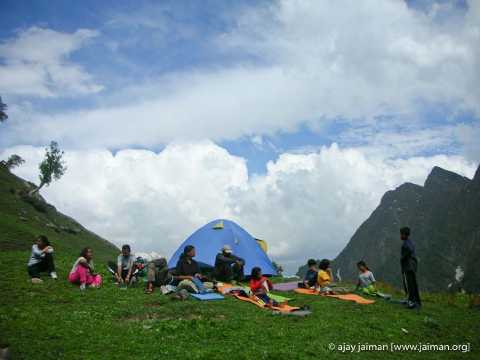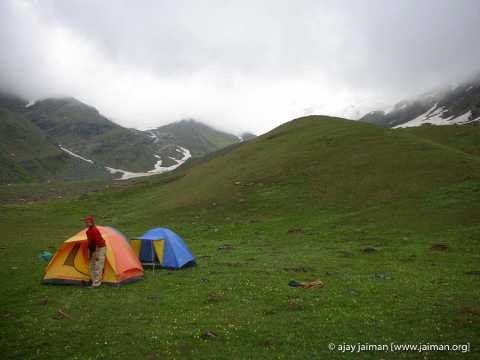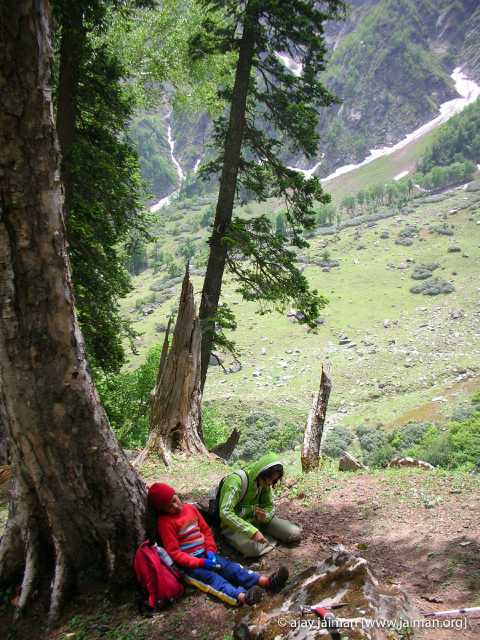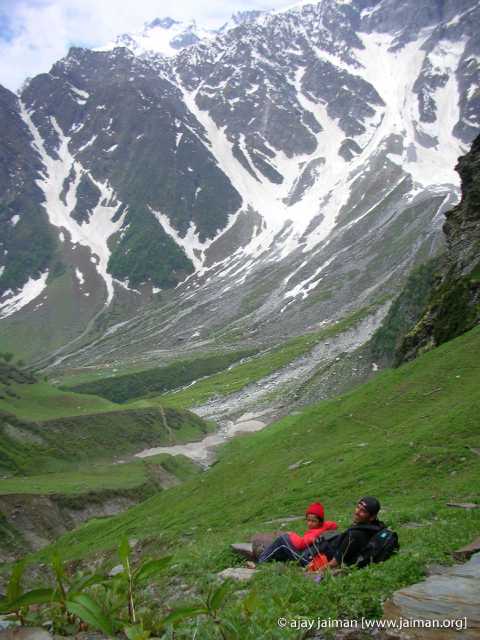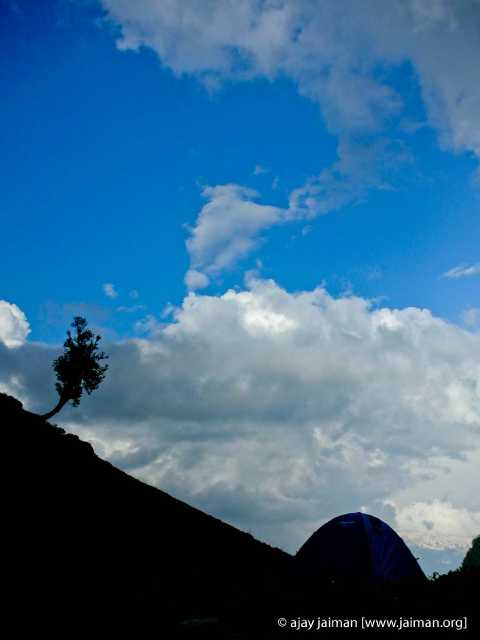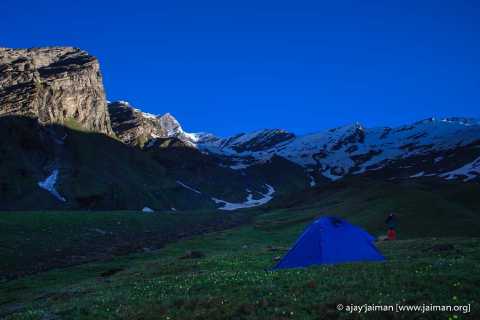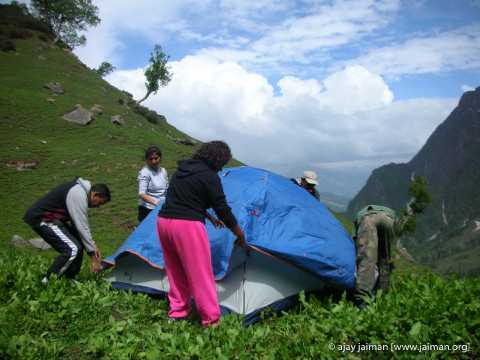Seven adults, five kids take a trek to Beas Kund, moving away from the trodden path and opting instead for a route that is spectacular, challenging, and at times, downright tricky. The oldest beyond 40; the youngest a little over 6. On our trekking holiday in Manali, we were joined by our friends, their friends, and two trekking titans. The result: a life-changing, mind-bending, muscle-opening experience that every one is just waiting to revisit.
Before you ramble through my mountain scramble, you might want to be introduced to some characters of this tale, some or all of whom may be unfamililar.
Swami: The Camp Commandant, friend and colleague of Ajay and Manas at HiWEL who put together this entire road show with logistic support from Katabatic Adventure Sports Team4Adventure. An avid, professional climber, whitewater rafter, kayaker, you name it, he’s done it.
Auro: Swami’s friend, robotics researcher and be-there-for-everyone who finds and makes the time for his avid interests, mountaineering, kayaking, rafting, and some strange adventures like joining up with our motley bunch most of whom wouldn’t know the frontside of a mountain from its backside.
Manas: Head of HiWel, Ajay’s friend/boss/companion in crime who said, “Sure, let’s climb some mountains together.”
Mimi: Manas’ better half, avid photographer, cheerful as sunshine, with compassion and understanding that probably makes her the great person and photographer that she is.
Rupali: Mimi’s college buddy with bounding spirit, relentless energy, and a knack for figuring out what the littlest member of the team wants to do.
Titli: Manas and Mimi’s 12-year-old daughter, a princess with the most beautiful smile ever, amazing energy and the brightest eyes in the universe.
Joey: Manas and Mimi’s 10-year-old son. The bounding kangaroo that reached every campsite first, that climbed every mountain unaided, and that woke up each morning before any other kid.
Laboni: Titli’s friend and the most delightful 10-year-old storyteller I have ever encountered. A bounding spirit that saw her way up ahead, and a smile that seemed to hold the treasures of Arabia.
Ajay: Husband, friend, companion, the bulldozer that has spent the last 16 years pushing me to get up and get ahead and experience the world first hand. He’s god as far as the kids (any kids) are concerned, a gentle soul who has the spirit of steel.
Arti: That’s me, just a confused writer who’s spent the better part of her life trying to make sense of the world through art, literature and education.
Siddharth: Ajay and Arti’s 11-year-old son who knows little fear when it comes to mountains but just ask him to sing a song in public…He’ll turn around and lend his mum a helping hand, even though it looks so weird, and in the privacy of his mind, he can compose the most fantastic poetry I’ve ever read.
Damini: Ajay and Arti’s six-year-old daughter. Like her name, she’s like a blinding light of lightning, sharp and strong. She knows her mind, knows her heart, wants her space and loves with a passion that is hard to believe.

Okay, that’s the cast. Now go ahead and travel the mountains with us.
I’ve tasted blood. This somewhat gory realisation came to me at the crack of dawn, sitting on an ice-cold stone in the freezing, breezing cold, outside a brilliant orange tent surrounded by a pergola of sheer peaks. To the right, a mountainside cloaked in green rises to meet the sky. To the left, jagged rocks shoot up, edges so sharp barely a clump of grass manages to hold on. In front, like the presiding deity, are the stunning snow-capped peaks of the Pir Panjal. Rolling down from their base is a carpet of green, dotted with yellow and pink flowers blooming along the edges of a young perky stream. My stone and my tent is on the edges of this carpet, before it drops several hundred feet to an ice-covered lake below, the much-revered Beas Kund in Himachal Pradesh.
I’ve always had a benevolent relationship with mountains. Nice places, great getaways, clean air, pretty stones, that sort of thing. These were places our family packed off to in the summer vacations, picnic basket and holdall in tow. There was Shimla (courtesy, a family home in crowded Boileauganj), Mussoorie (courtesy, a grandfather who used to book a hotel room for two months at a stretch and a grandmom who presided over the kitchen henceforth), Nainital (courtesy, an uncle who was posted in Bhimtal), Dalhousie (courtesy, a family friend from Pathankot who had a friend who owned a hotel there), and Kashmir (courtesy, a snap-happy neighbour who coaxed my dad to do something out of the ordinary). These were my childhood memories, of holidays spent with cousins, uncles, aunts, dogs, bossy grandmothers, an athletic grandfather, and parents keen on giving their children these fabulous memories.
But sitting there on that freezing rock, with spinach-like leaves getting crushed under my shoes, hot tea in a steel mug warming my hands, the clean biting wind making my nose run, and the first rays of the sun lighting up only the very tips of the snow-peaks, I realized that it was only now that I had truly discovered the magic of the mountains.

This was up close and personal. This was hard and painful and tiring. After a year spent recovering from a mysterious immune attack that left my joints stiff, my feet swollen, and my chest permanently conjested, here I was, mad enough to go along with my even madder husband’s idea that the entire family try a trek. What, in heaven’s name was I thinking of? I was breathless every 10 steps up the mountain track. By the time we reached the first day’s campsite after seven hours of walking, clambering, crawling and being hauled over, I simply collapsed, too tired to even see where the trek had brought me. Sturdier companions had already settled in, set up tents, and laid out mats in the sun. I didn’t think I could make it any further. If the sheer exhaustion wouldn’t get me, surely my fear of heights would.
I stared in horror as our friend and trek-guide Swami pointed out the next day’s route, on a narrow goat-path up the opposite mountain, up and up till we reached the very crest of those jagged rocks to a pass that would allow us to cross over into the valley below. “No problem,” he said, in what he probably thought was a reassuring tone. “It’s a simple walk and only the last bit is technical.” Technical!!! How about that, technically, I am paranoid about narrow paths, steep sides, high places, moving water, wild animals, you name it. No way, there was just no way I was going to be able to make that.
The night was freezing but that wasn’t what kept me awake. I kept reliving that path, that narrow path, so high, edges falling away to the glacier below. I tossed and turned, and just when I thought I was ready to give it all up, a strange noise erupted just outside my tent. It wasn’t human, and it certainly wasn’t the wind, which the tent was doing a pretty decent job of keeping out. I shook Ajay awake, only to find that a general pandemonium had erupted in the mess tent where the porters sleep. Apparently, they too had heard something. The next hour or two went in listening fearfully for the next bear-attack, hearing Swami and Auro check out the perimeter of the camp, and Mimi wondering if her kids were okay in the neighbouring tent. For some strange reason, I actually found the pandemonium soothing. It took my mind off that dreaded trek route, and before I knew it, I’d turned over and knocked off.
4.45a.m. That’s the time I woke up every day at camp. No alarm bells. No lights. No one to wake me up. Just some natural voice in the head that said, “Wake up, and see the light.” Even before I rubbed my eyes open, my hands would reach out for the tent zipper, open it a bit and check the sky. Blue sky, first light, the sun not yet out. Brilliant. It just took the threat of “first light” to get avid photographer Ajay out of his sleeping bag. By 5.15 he’d scrambled out, all topi-ed, gloved, jacketed, and even a quick visit to the loo. And off he went, climbing as high as he could go to get that perfect spot for the perfect picture.
This was my time too. My time to do everything in slow motion. Brush next to the crystal clear snowmelt in the stream, walk to the loo-tent through a field of flowers, find the perfect stone for some moments of stillness. Clutching a steaming hot cup of tea, this was my time to take it all in. So this is where I’ve come. Wow! How do you describe it? Forget it. I’ll just let Ajay’s photographs do the talking.
First light striking only the tallest peaks first. The western flank lit up by the eastern light. The camp slowly coming awake. Sounds from the kitchen tent. Mountains of eggs being boiled. Potatoes being cut. Tea being made. Birds whistling in the wind. Tents being zipped open as people sense the warmth of the sun coming through. Kids waking up, tramping to other tents to see who is awake. Brushing, washing (ouch, cold!) changing, getting ready for the day ahead. Savouring these sights, sounds and smells, I even forgot that the lovely, sunlit mountain opposite our campsite had been looming large as a nightmare the night before.
Next thing I knew, a breakfast of pancakes and eggs and bread and milk and cornflakes (good heavens, it was a veritable feast) was over. Tents was packed, bags were loaded, backpacks were checked, and down we went for another uphill day.
I still hadn’t found my mountain feet, as it were. (I discovered them on the last part of the last day. Just goes to show that a trek needs to be certainly longer than four days.) We had to slipslide down to the stream, cross over and start up that goat path I mentioned earlier. It somehow didn’t seem so hard at first. Just an incline climb on a narrow path (which somehow didn’t seem so narrow now that my shoes were on it). I guess I thought too soon. Pretty soon, the nightmare turned to reality. I just didn’t have time to think about that. As we headed up the steep incline that rose sharply up to meet that mythical “technical” pass, I was too busy not looking down, keeping my eyes glued to the clump of rock, grass or whatever I was supposed to step on next, and definitely not looking up.

We finally stopped on an early lunch on a bunch of rocks. Tuna-sabzi wrapped in rotis, (alu-gobhi for the grass-eaters like me), dry fruits, toffees and an orange. Wholesome, energetic and basically too much for a body focusing solely on putting one foot before the other. Swami, of the “I don’t do lunch” fame wolfed down his share of rotis only to be outdone by Auro, who was being touted as the ultimate “scavenger” by Swami. The rest of us barely managed to do justice to half the lunch, leaving the rest for “later.” In my mind, a passing thought whispered out, “Later, when later? When we’re left stranded on the pass for the night? When the bear comes loping out of those clump of bushes down below? On such sundry cheerful thoughts, I picked up body and soul and started on the rest of the climb.
Whether it was the lunch, or just the big mistake of looking at the height we’d gained, I rediscovered the terror of heights just after lunch. For one, the path kind of disappeared. Perhaps the sheep lying down on the patch of glacier could have seen it. Perhaps, the shepherd huddled nearby could see it. Perhaps seasoned climbers like Swami, Auro, the kids, could see it. I couldn’t. So, I simply froze. Finally, Auro did what Swami, Ajay, Manas, the porters, and at one point, even my son Siddharth, would do for the rest of the trek. Haul me across these “fear-freeze points.” Holding tight, I finally got the confidence to take a step up, then another, and another till I was back on what the sheep and Swami might call “the path.” This was like a metaphor for life and philosophical discovery. But it was only much later, in the dawn light on the last morning outside my tent, that I was to see it that way.
At the pass. Across the pass. Down the pass. That’s what the pass was, technically, all about. Before I could think, and before I could freeze again, the guys had hauled me up and the porters had hand-held me down the near-vertical climb from the edge of the pass to the so-called path below. All the way down to the glacier, Suresh and Swami held onto my hand, constantly saying, “Don’t stop, don’t worry, don’t slow down.” And, sure enough, before I could say Pir Panjal, I was at the glacier’s edge. Down came Rupali behind me. I was just admiring her guts and gumption and her sure-footedness, when she suddenly slipped. Fortunately, a porter grabbed on in the nick of time and put her back on her feet. Here was someone who had done the entire trek so far at the head of the team. Crossed 40, but what a show. I was wondering if I’d ever get there once I hit 40 in just a couple more years.
At the glacier, the nightmare became white, cold, slippery and a straight slide down to oblivion.
Suresh had carried Damini up the mountain pass, down the mountain side, across the glacier and up the steep wall beyond. God bless that man made of steel.
As for us, Rupali slipped first step on. Bad shoes, since her earlier ones had died on her the day before. Slipping and sliding and looking very much in danger of making the trip down, she made it across with the help of two porters hanging on for dear life. I could have done with two, but I guess Swami had infinite faith in my capacity to keel over. So, in the photos, you have two porters holding on, and Swami right behind ready to clamp on at the first slip. Of course I made it across (which is why I can still write this), but I couldn’t even savour my success. The edge of the glacier was a wall of green. A wall. I kid you not. And, by some bizarre stretch of logic, Swami saw a path. Where? The porters seemed to think it could be done, so putting my faith in their hands – literally – off I went clambering up the wall, holding on to clumps, bumps, lumps, anything. At one point, I looked down. Big mistake. I looked up. Even bigger mistake. So, I froze, thought of shedding a few self-pitying tears, then decided I looked pathetic enough as it is, and finally thawed enough to move on.
At the top was Mimi, triumphantly greeting each new entrant to this mountainous field of dreams. I collapsed next to her. Minutes later, Siddharth followed, trembling and teary-eyed. I moved back, let him collapse in my lap and kept rubbing his head till he looked as if he had calmed down. A short walk down, and we were at the campsite. The kitchen tent was letting out reassuring whisps of smoke, the mess tent was up and inviting, and mats had been spread out in the sun for pooped out people like me. For once, I wasn’t the only one. Practically everyone looked back with horror and awe, and I guess pride, at the distance and landscape they’d covered.

This was to be our base camp for Beas Kund, and something told me no one wanted to move base. It wasn’t just that we were tired (and how!). It was more that this was something out of a fairy tale. Our tents were in a rolling green meadow, rising up gently to the snow peaks of the Pir Panjal (one of which, the Shetidar, Swami and Auro have even summitted), flanked by bubbling streams, wildflowers, and the vaulting rise of the rocky mountainface we had just climbed over. From this side, I could see the ancient rock core of granite, gneisses, quartz rocks and slates that had once been covered by glaciers in the last Ice Age. It was like seeing pre-history laid bare. I could imagine these rocks once part of the ancient Tethys Sea, pushed up as that piece of Gondwanaland that became India crashed against mainland Asia. I’d spent nearly a year writing a social studies book for Class 5 children, and all that reading and writing about how the first continents were formed came back in a flash.
Lunch and Uno, campfire songs, stories and porters’ tales, Mimi and Manas regaling us with Bengali songs, Rupali and I suddenly discovering that it’s freezing cold and putting on every available piece of clothing, and finally tucking into our sleeping bags only to discover that our tent was set up on a sloping site. The better part of the night was spent shuffling and uncrumbling. By morning, everyone looked like it had been a long night. No bears, thank god, but what a slide, night, slide-night, whatever.
Once again, 4.45am. Zip open. Blue sky, first light. Ajay scrambles out of the sleeping bag and he’s off to climb the mountain. I wonder if he’ll accidentally summit one day. While he’s away, I try out different rocks to sit on. Big flat rock with one cup of tea. Closer-to-edge lumpy rock with second cup of tea. Small, short rock after morning loo-trip. And finally, back to big flat rock for third cup of tea. Ajay is back down. (I guess he didn’t summit after all). I grab some video footage while he keeps shooting. Rupali emerges from her tent. Grabs her mug of hot water and takes in the sun doing its light-show on the top peaks. Half the camp is in the shade, half in the sun, when Manas and Joey emerge. Soon, noises come out of Titli and Laboni’s tent too. And pretty soon, everyone is up and out, and definitely not raring to go.
Lazy breakfast, even slower wrapping up of tents and stuff, and finally, we dig our heels in and refuse to budge. Mimi looks at the watch, and we collectively decide that there’s no rush. We’d like to lie among the wildflowers, soak sun and generally enjoy this fabulous place we worked so hard to reach.
Swami grumbles, but settles down on a rock. Auro lies back, covers his face with his cap, and is seemingly snoozing. Mimi, Rupali and I sit back against the backpacks and do a round of sunscreen, discovered a tad late since most of us are now burnt to a crisp. In a rather belated sense of maternal concern, we round up the kids and practically lather them with SPF45. That done, we sit back contended. Now, the kids can bake themselves silly.
Finally, at 11.30am Swami starts fidgeting. We may be shameless, but we get the message. Reluctantly, we get up, dust our bums, put on our caps, take a parting swig of water, and start rolling downhill. It’s a lovely walk through purple irises, yellow wildflowers and lots more of that spinachy stuff I saw in the first camp. We cross the stream (on our own, thank you) and walk down, all chatty and comfy. That’s an indication of just how easy the walk to the final camp was. We reach a muddy, slippery path, Mimi and I look at each other, wondering how this one has to be tackled. Mimi says she’s going to slide down on her bums and promptly does so. I need to recover some lost ground as the official “live chicken” of the bunch, so I bravely attempt it standing up.
Halfway down, slipping along quite nicely, Auro comes up and gives me a helping hand down. I try to suggest I’m fine, but I think he thinks I’m holding up traffic. So I just tumble down and before I know it, we’re on the edge of the ice-covered Beas Kund. It’s all blue and green, and looks deeper than anything I’ve seen. The ice on top is rather mucky, and Swami says it’s normally all gone by the end of summer. Locals worship this water, use it like Gangajal for all their ceremonies and don’t like anyone camping near it. Good idea.
Auro talks about how Rishi Vyas is supposed to have written the Mahabharata here. Then, there was some myth about an ashram below the Kund. Mimi and I, fresh out of reading Ashok Banker’s seven-part Ramayana suddenly recall the story about Rishi Agastya and his wife Aditi and wonder if this could be the place. Good fun, all this story swapping. But it really gets me thinking about all the opportunities I lost learning all this stuff from my grandmother (a Sanskrit scholar of the highest calibre who died when I was 15) or my grandfather who had a slightly irreverent but equally knowledgeable take on myths and legends who died just as I was entering college and discovering the world beyond my protected and somewhat cloistered existence.
We sit here for quite a while. For once, even Swami seems in no hurry. The camp is just across a mile of moraine, so we might as well enjoy this moment of quiet. Ajay, as usual, starts climbing up the mountainside along the Kund (which might just bring him back up to our earlier night’s campsite!). Laboni and Titli clamber down to the edge of the Kund, pop a few stones in and then retreat back up. Then Damini clambers down. Auro follows and they spend the next 20 minutes ruminating on the water. Rupali decides things could liven up. She unseats Auro, and teams up with Damini for some serious “let’s throw the pebbles” fun. They aim for the ice, aim for the water, measure their ripples, and generally are oblivious to the fact that Swami has finally decided we’ve got to move on. Mimi meanwhile does a quick round of Kapalabharati and Anulom-Vilom. I’m wondering if I should follow, but decide, “Hang it!” Time enough for that when I am back in Gurgaon. Right now, I just want to breathe in and out without thinking too much about it.

We finally move. The green gives way to grey. It’s like an MCD demolition site, mounds and mounds of rocks, some as large as cars, others as small as, well, dinky cars. They’ve been left here by a receding glacier. I throw out a quick geography lesson for Titli, Damini and Laboni (poor Siddharth had to go through my manuscript so I figured I’d leave him out for now) about how the moraine is created. Mimi does a helpful, “Listen to Arti auntie!” which practically makes me shut up since the last thing I want to do is to get a lesson going. But the girls are interested so I ramble on nonetheless.
After this hop-skip-jump-climb-clamber over the moraine littered valley we reach a gushing stream. In anticipation, the porters are there to help us across and some like Suresh have even put their rubber boots on (why freeze?) Shoes off, tracks rolled up, we go screaming, howling, hand-holding across the icy water with the rocks and pebbles digging helpfully into our bare soles. Good fun. Manas lands at the other end with a few choice expletives. Mimi decides to start screaming even before crossing. Laboni skips the whole deal and simply crosses on Suresh’s back, and Auro walks across like it’s a walk in the park. Ajay is cool, except for his beloved camera bag, which he reluctantly hands over to the porters, just in case. Siddharth loses balance halfway and is hauled the rest of the way by Suresh. Damini never even gets to put her delicate toes in the water, since she’s piggyback on Suresh. The camp is set up on the edge of stream two, a shallow gurgle that really doesn’t require any help. But since we’ve created such a ruckus out at stream one, the porters hang around. You never know who’ll get washed away by 4-inch deep water!
We cross. I walk across, no screaming, no hand-holding, but the water still is a killer. At the other end, Rupali and I sun our toes and dry our tracks. Mimi, down with an upset tummy, collapses on a mat. The kids and Auro refuse to pass up the opportunities of all that water gurgling by. On two lumps of land, one of them christened Auro’s Island, they have a stone-throwing, mud-pie making session, with Joey and Siddharth taking every opportunity to walk into the water. Finally, Mimi throws a fit and gets Manas to pull the kids out before they catch a chill. Damini is still making mud-pies but finally gets up when Titli, Laboni and Auro decide to move.
Mimi is in agony. I don’t have any adult medicines to help with the gastric cramps but a great paediatric one. When I mention it, she yelps, “Oh, just give me three spoons of the stuff.” So I pull out smelly Carmicide and feed her a horse dose. Minutes later, Suresh comes to say that a porter has a bad cold and fever. I have fever tablets, but nothing for a cold, except well, paediatric medicine. Mimi, much better now, grins and says, “Isko bhi double dose de do.” So, out comes Abrodil Plus and I ask the poor guy to gulp down three spoonfulls. I think it worked (or it didn’t) cos he never came back for more.
That evening, we had a lovely, long song and story session in the mess tent before dinner. Damini told a joke, Siddharth told a riddle and I backed him up with the song “There was an old lady who swallowed a fly.”. Joey told a strange tale that’s got lost in the mists of my mind. Titli did too. Laboni told a fantastic, long and elaborate tale drawn from Indian mythology that really showed up her extraordinary story-telling abilities. She even popped in with some Shel Silverstein poems which reminded me of some I’ve heard on the World Space promo back in our Pitara days.
Auro told a lovely tale about why the Vindhyas are not the highest mountains in the world anymore, once again showing us all what a marvelous repertoire of stories, experiences and anecdotes he has. Mimi and Manas did some great Bengali duets – they really make a great pair. And, before I had time to wrack my brains, it was my turn. I spun off one of the Titli-tales I used to tell Damini when she was three or four. I thought it was rather tame (maybe even insipid) but the kids seemed to like it and kept asking, “What happened next?” like it was some detective story.
The winner, besides Laboni, was Ajay’s long-winding but gripping tale of the Yeti, something he’s been reeling out to both Siddharth and Damini for the last seven or eight years. He cut out the other characters, and kept it focused on the Yeti, but it was great. Damini, lolling on his lap, kept adding bit and pieces as and when she felt that he was leaving out a crucial bit. Mimi was looking anxious. Was this Yeti story going to keep the kids up at night? She needn’t have worried. Ajay’s spent his entire life breaking stereotypes and he wasn’t about to churn out a scary Yeti now.
Once again, Swami’s cook Dhruv-ji outdid himself, with a spread of chicken, paneer, veggies and even a dessert, yummy chocolate pudding that had the usual petoos – Ajay, Auro, Swami – taking seconds. This was our final night. Tomorrow, we would walk all the way back to Dhundhi, from where some four-wheeled vehicle would haul us back to our hotel in Manali.

We slowly curled into our tents (nice soft flat ground this time), and spent the next hour just trying to fathom the experience of the last three days. I’d promised myself on night one that if I ever get out of this place alive, I’d never say yes to a trek ever again. Well, it looked like I’d get back to Manali alive and kicking, and somehow, the thought of never doing this again seemed, almost, sacrilege. Not walk these mountains? Not cross these freezing streams? Not wake up to first light in a cradle of peaks? No way. I’d tasted blood. And, whether I liked it or not, whether my muscles ached, joints screamed, I just had to come back for more.
First light the next morning felt almost kind of sad, like seeing the best moments of your life slipping by. Ajay crossed the stream, and did what he always does, climb up to his vantage point. I explored assorted rocks. Flat rock near our tent for first cup of tea (it was a great plate for Rupali to lie down the previous day). Then I moved to the other side of the mess tent and plonked myself on a high rock and mused on the eastern face of the Shetidar getting its first light. Noises from the mess tent got me moving again. I didn’t want to get in the way of the porters waking up. So back near the stream with another cup of tea. Pretty soon Rupali tumbled out, followed by Manas and Joey. Surprisingly, every day, we had the same order, first Ajay and I, then Rupali, then Manas and Joey, then Mimi, Titli and Laboni, then Swami and Auro, and finally, Siddharth and Damini.
Laboni decided to scratch Auro’s tent to see if she could scare him into thinking a bear had popped in. And dropped a chunk of ice at his doorstep so that he could step into it. I don’t think he even noticed. Just goes to show, we don’t make very good bears.
A quick breakfast and Swami was back to camp commandant mode. He and Auro went off to search for a missing ice-axe and shooed us onto the path back, with Dhruv-ji and China Ram for company. We crossed some three freezing streams before reaching the moraine covered slope we were meant to climb. After the usual screaming, shouting and hand-holding we took a bit of a breather and started to climb. Over the next two hours we walked over enormous boulders scattered over a glacier. I returned to my petrified self, but was helped along by Ajay, Manas and China-ram ji. It was only in the last bit down, that I felt I could make it on my own. Somewhere I found the courage to put my feet on shifting ground and not keel over.
Swami and Auro joined us just before we made out descent. The ice axe was lost.

The rest of the walk back was a breeze. Climbing up was never this easy. After what we’d just done, every slope seemed like a walk in the park. Back at the Beas, we had to cross those three log-lashed bridges. Somehow it didn’t seem so hard, though I figured I might as well last till Dhundi, so no harm in being hand-held across the gushing waters.
At Dhundi, absolutely pooped and ready to drop, Swami’s troops were waiting. Mahesh in his Sumo, and a tractor and trolley. The choice was ours. With a wild whoop, the kids launched themselves in the trolley. The adults figured, why end the adventure and followed. Ultimately, it was only porters and luggage in the Sumo.
The tractor revved up, belched out a gust of smoke, and lurched forward. We thought the swirl of dust rising to meet our hair, our faces, our noses and our mouths, was so much fun. Fifteen minutes later, all of us sat jolting and rattling, grim faced and grey-haired, just waiting for the journey to end. Near Solang, a foreigner in a three-wheeler saw us, pulled out a camera and started taking snaps. Manas, ever the mimic, did his BBC reporter-type report of how the “Natives of India travel in a strange vehicle drawn by a tractor. It seems, by their dress, that they are quite well off.” We would have guffawed all the way to Manali except that the dust had now made its way into our throats. So, it was lips sealed till further notice.
When we finally rolled up the Ekant Hotel driveway, after encountering the curious stares of passing passengers in more respectable fare like Indicas and Esteems, all we wanted was a bath and a hot cup of tea. First thing, the geysers came on. Next the tea was ordered. An hour later, clean and scrubbed like we’d practically scraped all our burnt skin off, we were all huddled in a daze around the table in the balcony. Mimi tried to explain what a marvelous experience it was. But I think there was just too much to say, and no words to say it with. Bottom-line: we were all hooked and like it or not, Swami would have to take this motley bunch up the mountain again, and again, and again.
Back in Delhi, I’m wondering if I will be jeopardizing my job if I casually mention that I’m looking at another mountain break, say, in another three months. October seems like a nice time. The rains would be over. The kids have a break. I think three months is about as long as I could last. Ajay has a rather self-satisfied grin on his face the last few days. He’s spent the last 12 years that we’ve been married trying to get the mountain bug to bite me. It just did.

First published on June 19, 2006
#photography, #photo-features, #travel, #adventures, #himachal pradesh, #hiking, #trekking, #walking
You may also be interested in these related posts:
Bhaji on the bypass
Driving round the bends in Himachal

